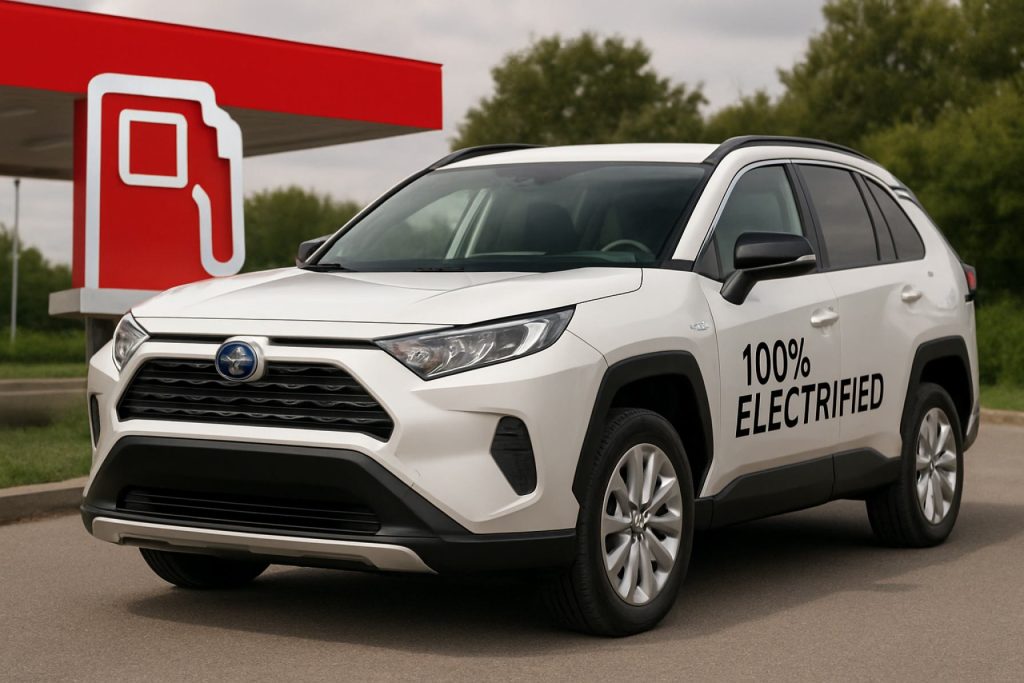
- 2026 RAV4 drops pure gasoline; only hybrid and plug-in hybrid (PHEV) models remain.
- Woodland and GR SPORT trims focus on rugged looks and sporty flair.
- PHEV electric-only range climbs to 50 miles; DC fast charging available on select trims.
- No fully electric (BEV) RAV4—Toyota reserves all-EV tech for its “bZ” range.
- Marketing touts “100% electrified,” but all models retain a gas engine—true zero-emission driving remains elusive.
- Exact EPA fuel economy and pricing details are pending; release is expected later this year.
- The new RAV4 marks progress, but Toyota’s messaging blurs the line between hybrid and electric for consumers.
The pavement glistens as rain lifts the scent of summer from the city’s tired concrete. In a nearby dealership, Toyota‘s 2026 RAV4 sits under strategic floodlights, bolder and more muscular than ever. This is no ordinary refresh. It’s a radical shift: America’s bestseller is now only available as a hybrid (HEV) or plug-in hybrid (PHEV). The all-gas RAV4 is gone, replaced by what the automaker trumpets as “100% electrified.” But behind the swirl of green-tinged marketing, a more complicated story hums just beneath the hood.
Picture it—sleek Woodland trim gleaming, black cladding ready for adventure, while the GR SPORT version flexes an outsized, athletic posture. Underneath, upgraded hybrid powertrains whisper promises of power and thrift. The PHEV’s electric-only range leaps from 42 to 50 miles, enough to conquer the average suburban commute—if drivers remember to plug in.
- All trims: Hybrid or Plug-In Hybrid only—no pure combustion left.
- Woodland: Rugged, outdoors-focused styling mirrors Toyota’s broader push for adventure aesthetics.
- GR SPORT: High-performance touches, despite the RAV4’s family SUV DNA.
- PHEV Range: 50 miles on electric alone—an improvement, though still modest.
- DC Fast Charging: Some trims now charge from 10% to 80% in 30 minutes.
But the marketing shines brighter than any chrome accents or LED strip. “100% electrified,” Toyota crows in splashy banners, dripping with eco-friendly promise. And yet, pop the hood of every single 2026 RAV4 and you’ll find—without exception—a gasoline engine humming alongside the battery. The phrase dances just outside the plain truth, banking on confusion between “electrified” (hybrid) and “electric” (no gas at all).
The auto industry’s lexicon is a maze: EV, HEV, PHEV, EREV, FCEV, BEV. True Tesla-style “100% electric” vehicles run exclusively on battery power. The new RAV4 PHEV is a step toward greener streets but not a leap into the emission-free future some shoppers crave.
This calculated ambiguity isn’t new for Toyota. The company’s storied history includes aggressive lobbying against climate policy and regulatory scrutiny for advertising that blurred the honest distinction between electrically assisted and fully electric drivetrains. With the 2026 move, they’ve pressed further—boldly labeling a gas-dependent lineup as “100% electrified.”
- No pure EV in the RAV4 family. Toyota appears content to reserve BEVs for the bZ lineup.
- Official EPA numbers? Still TBA, but look for ballpark gains over today’s 39mpg hybrid model.
- Availability: Hitting Toyota dealerships nationwide later this year. Pricing remains under wraps.
The Bottom Line? Toyota’s RAV4 refresh is a milestone—shedding the all-gas powertrain and doubling down on efficiency. Yet, the automaker’s decision to redefine “100% electrified” risks muddying the waters for car buyers trying to make climate-conscious choices. It’s a lesson: behind every claim, read the specs as well as the slogans.
For those truly seeking a future free from gasoline, take heart—innovation inches forward, if haltingly, under the glare of the showroom lights. The journey to zero emissions is more marathon than sprint, and every automaker’s wordplay counts.
You Won’t Believe What “100% Electrified” Really Means for the 2026 Toyota RAV4!
-
Pros:
- Hybrid and PHEV Options Only: The new Toyota RAV4 lineup eliminates pure gas engines, pushing for greater fuel efficiency and lower on-road emissions.
- Improved Electric Range: The plug-in version (PHEV) boosts electric-only miles to 50, covering many daily commutes with zero tailpipe emissions—if charged regularly.
- Faster Charging: Select trims now feature DC Fast Charging technology, enabling top-ups from 10% to 80% in about 30 minutes.
- Distinct Styling: Unique trims like Woodland and GR SPORT offer both adventurous aesthetics and sportier performance features.
- Nationwide Availability: Arriving soon at Toyota dealers across the US.
-
Cons & Limitations:
- No Fully Electric RAV4: There is no BEV (Battery Electric Vehicle) option; gasoline engines remain in every model.
- “100% Electrified” Confusion: The marketing blurs the line between hybrid (gas-assisted) and full electric, creating potential confusion for buyers seeking true EVs like those from Tesla.
- Lobbying History: Toyota has a past of opposing stringent climate policies and received regulatory criticism for ambiguous advertising regarding electrification.
- EPA Numbers Pending: Official mpg ratings are not yet published, so real-world efficiency gains remain uncertain.
- Price Undisclosed: With no official pricing announced, cost competitiveness is still unknown.
- Partial Progress Only: The step away from gas-only is commendable, but those wanting a vehicle with zero gasoline reliance will need to look elsewhere (e.g., the bZ series).
-
Controversies:
- Marketing Terminology: The “100% electrified” slogan used by Toyota is controversial for implying zero gasoline usage, even though all models are hybrids or plug-in hybrids, not pure electrics.
- Regulatory Scrutiny: The company has faced past criticism from regulators and environmental groups over advertising that could mislead customers about emissions and drivetrain technology.
The bottom line: The 2026 Toyota RAV4 moves the needle on electrified options, but beware of buzzwords. For 100% electric freedom, shoppers may want to explore the offerings from brands like Tesla.
What’s Next for RAV4 and the Hybrid Revolution? Electrification Surprises Ahead!
-
Growing Hybrid Dominance:
Following Toyota’s bold move to an all-hybrid and plug-in hybrid RAV4 lineup, expect other mainstream automakers to accelerate similar transitions. Conventional gas-only SUVs will likely become a rarity in showrooms by the late 2020s, as hybridization becomes the default for affordability, emissions, and regulatory pressures.
-
Slow Path to Pure Electrification:
Despite eco-forward marketing, most automakers—including Toyota—are expected to highlight hybrids and PHEVs rather than leap fully into electric vehicle (EV) territory right away. Pure BEVs may remain limited to specialty or dedicated lines (like the bZ series) for the next several years, with mass-market models trickling in gradually.
-
Regulatory and Policy Drivers:
Tighter emissions and efficiency standards in major markets will pressure automakers to further boost the electric range and efficiency of hybrids and PHEVs. Watch for upcoming model years to tout longer electric-only mileage and faster charging capabilities as buyers demand more practical eco-credentials.
-
Consumer Clarity on “Electrified” vs. “Electric”:
Public confusion (and some frustration) around marketing terms will spark stronger calls for transparency. Expect watchdogs and regulators to push for clearer labeling as consumers learn to look past slogans when choosing between hybrid, plug-in, and all-electric vehicles.
-
Competitive Surprises:
Don’t count out rivals like Tesla—whose BEVs set the benchmark for zero-emission driving. As battery costs fall and infrastructure improves, a price war between longer-range PHEVs and inexpensive BEVs could erupt, transforming the landscape by the end of the decade.
-
Forecast:
By 2030, plug-in and fully-electric SUVs are expected to make up the majority of new sales in North America and Europe. Automakers who lead in range, charging speed, and transparency will claim the hearts (and wallets) of the next generation of drivers.
The big picture? The shift away from pure gasoline is just beginning. Whether you cheer for Toyota, eye the next Tesla, or follow new innovators, the next five years promise more choices—and more debate—than ever on the road to true electrification.



